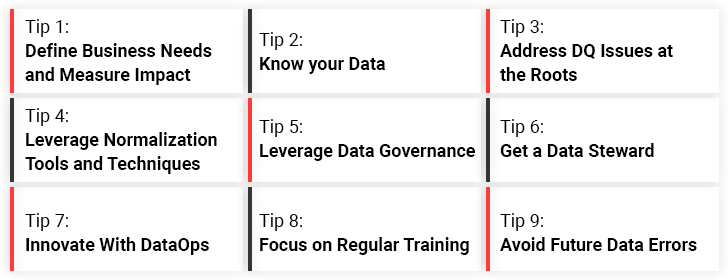High-quality data is important and this fact is documented by businesses, regardless of their size or scope throughout the different industry verticals. And, the Covid-19 pandemic only accentuated this better. Hence, achieving high DQ is a top business priority for data-driven organizations.
After all, high DQ ensures accurate outcomes of quantitative research, trusted reporting and analytics, greater success at AI initiatives, optimized operational processes, superior customer experience, and an even higher ROI. The best start to the DQ improvement process is by developing an organization-wide strategy that onboards everyone in the company to work collectively towards building a culture that fosters quality data.
Tips to Create an Effective DQ Strategy
A data quality strategy is one that defines processes and systems to include DQ in all business activities to ascertain that only trusted data is used across the length and breadth of the organization. A result-oriented strategy apprehends business objectives, goals, processes, initiatives, and scope to enhance DQ along with integrity. Defining a DQ strategy enables businesses to identify, resolve, as well as prevent quality issues to build a stronger foundation of trusted data—and this is where B2B data cleansing services help.
Listed here are some of the important tips to improve the quality of your data and get the best out of your data investments:
Tip 1: Define Business Needs and Measure Impact
Well-defined business needs to drive DQ improvement initiatives. Begin with prioritizing issues based on the company’s needs and how these might impact your organization in the long run. This will help establish a realistic goal as well as keep a check on the progress of quality improvement initiatives. Further, continuous reference to the organizational needs provides the context for refining your approach to quality data.
Tip 2: Know your Data
Not all data is equal, meaning that not all pieces of information out there are relevant for your business; hence, the key here is to understand your data. This means that businesses not only need data that is ‘right’ for trusted users, but you also need the ‘right’ data to lay a stronger foundation. You should know your data correctly—what it contains, what is its source, how to extract value from it, etc., to determine if it is ‘right’ or relevant for your intended business use case.
After all, data intelligence is the ability to understand the data correctly and leverage it in the right way. Correctly describing and connecting the dots (here data) throughout its journey is an ideal approach to enhance DQ.
Tip 3: Address DQ Issues at the Roots
Data quality issues are often fixed temporarily so that the work isn’t impacted. For instance, what do data scientists do when they find incomplete entries in their selected datasets? They are most likely to fix those errors in their copy and proceed with their data processing and analysis. However, the original dataset still has those quality issues as the corrections do not reach the source, negatively impacting its subsequent use. As the adage goes, ‘prevention is better than cure,’ preventing dirty data from propagating is one way you can improve your DQ.
Take another example where a healthcare staff faced difficulties contacting patients after their visits. To deal with this, they decided to address this issue at the source when they discovered that the contact numbers were wrong for various patients. These patients were then asked to verify their phone numbers while checking in. As a result, this eliminated the quality issue in datasets quickly.
Tip 4: Leverage Normalization Tools and Techniques
Users sometimes make mistakes (incorrect spellings especially) while entering data in different forms. For example, they might write ‘treu’ for ‘true’ in a hurry and then forget about it. However, picking up such incorrect entries for analysis can seriously impact your DQ.
Hence, leveraging a defined list of values whenever possible leaves no room for users to make such types of mistakes. Besides, an experienced data formatting company leverages the right-fit normalization tools and techniques to rectify inconsistencies and errors and enhance the dataset quality.
Tip 5: Leverage Data Governance
Naturally, everyone within a data-driven organization needs to acknowledge their part in improving the quality of data. Develop a shared definition of high-quality data that is well-spread across the company, define unique metrics, continuously assess those defined metrics, and go for error rectification. Businesses can also rely on data governance measures to not only standardize their data management but also enhance its quality.
Tip 6: Get a Data Steward
Appoint a data steward to manage the quality of your data as you foster a data-based culture in your organization. They can analyze the quality of data, streamline quality check processes, as well as implement the necessary tools. Their responsibilities also include managing metadata and overseeing data governance. Additionally, a data steward guarantees clear accountability and complete supervision in a company.
Tip 7: Innovate With DataOps
Leveraging DataOps enables businesses to focus on process DQ automation, enhancing the quality of data analytics. The automation of the DQ process results in activated data, which can be further harnessed for maximum business value across all tiers—right from infrastructure to experience and everything in between. Not only this, you can also add automation to human behaviors with DataOps to define, assess as well as rectify DQ failures.
Tip 8: Focus on Regular Training
A data-driven culture guarantees a buy-in from everyone in the company to ensure high DQ. At the same time, it is vital to sustain their contribution and/or interest via innovative ideas. This can be done by providing regular training in concepts, metrics, and tool usage and can reinforce the needs and highlight the benefits of using good quality data; whereas, sharing of success stories and escalating quality issues across the enterprise can act as friendly reminders.
Tip 9: Avoid Future Data Errors
Keeping a check on the quality of data is about rectifying current errors while preventing future errors–the key here is evaluating and addressing the causes of DQ issues at the root of a company. An ideal strategy should allow easy integration of DQ best practices in business processes to reap higher ROI. And, the data cleansing services you choose should focus on delivering high-quality results.
Conclusion
Businesses can ensure the quality of data at the moment it is used by correcting errors at the moment data is created as well as remitting quality issues at the roots. Collaborating with data cleansing service providers helps improve data quality and nurtures a data-oriented culture that steers success and sustainable growth for the organization.
Read here the original blog: https://www.damcogroup.com/blogs/strategies-for-improving-data-quality-through-data-cleansing








